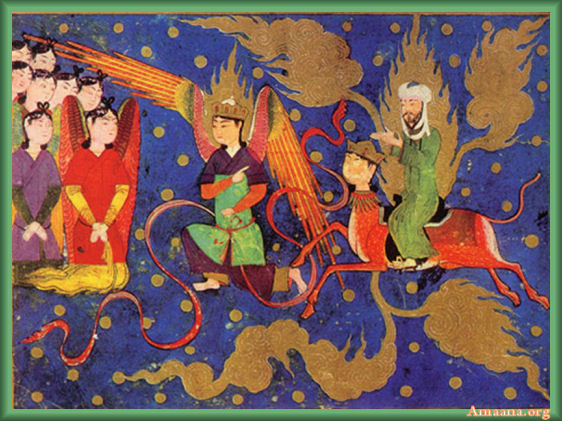An Esoteric Interpretation of the Mi’raj and the Prophetic Tradition ‘I Have a Time with God’ (li ma’a Allah waqt)
Jehangir A. Merchant
While Muslim artists created marvellous miniatures depicting the Prophet’s mi’raj (ascension) between arrays of fanciful clouds in gold and radiant colours with delightful angels serving him, Muslim poets in their admiration of the event soared high into their imaginative world and portrayed the Prophet in all his glory, flying through the seven heavens to the Mysterious Beyond in the Holy Presence of his God. Over time, a considerable amount of literature grew around the mi’raj of the Prophet. The following is one such expression which can be found among esoteric circles in Islam:
God sent out Gabriel:
“My Muhammad shall come!” He said.
“Take Buraq, draw it before him,
My Muhammad shall mount!” He said.“He shall go to the city of Medina,
In front of him angels shall fly.
The door of paradise shall open,
My Muhammad shall enter,” He said.“My Muhammad shall come, shall come,
He shall see and look at My Throne;
He shall pluck the roses of Paradise,
My Muhammad shall smell them,” He said…’ [1]
The original theme of Prophet Muhammad’s (s.a.s.) mi’raj upon which the wealth of mi’raj literature has grown, including the above excerpts, is referred to very briefly in the opening verse of chapter 17 of the Holy Qur’an entitled al-Isra (The Nocturnal Journey). [2] It says:
“Glory be to Him Who carried His servant by night from the Sacred Place of Worship (al-masjid al-haram) to the Far Distant Place of Worship (al-masjid al-aqsa) [3] whose precincts We have blessed, that We might show him Our signs. Lo! He alone is the Hearer, the Seer.”
The theme is further expanded in the first eighteen verses of Chapter 53, al-Najm (The Star):
“By the star when it sets, your compatriot errs not, nor is he deceived; nor does he speak of (his own) desire. It is nothing save an inspiration that is inspired, which One of Mighty Powers has taught him, endued with Wisdom. And he grew clear to view when he was on the uppermost horizon. Then he drew near and came closer till he was at the distance of two bows-length or even closer.
“And He revealed unto His servant that which He revealed. His heart lied not (in seeing) what he saw.
“Do you then dispute with him concerning what he saw? And indeed, he had seen Him yet another time, near the Lote Tree (Sidrat al-muntaha) [4] of the utmost boundary, near which is the Garden of Repose (jannat al-ma’wa). When the Lote Tree was shrouded (in mystery), his sight swerved not, nor did it wander. Verily he saw the greatest of the signs of his Lord.”
Read more onSimerg com
*****
Miraj wa Isra – Ascension and Night Journey of Prophet Muhammad

Miraj – Spiritual or Corporeal
By Mumtaz Ali Tajddin S. Ali
The word miraj is derived from uruj means to ascend. The Koran (70:4) says, “To Him ascend the angels and soul” (taruljul malaikatu war’ruhi ilaihi), and in 97:4: “Angels and soul (from Him) descend (tanz’zalul malaikatu wa’ruhi), and also in 70:3: “Lord of the ways of ascent” (minal’lahi zil ma’arij).
The miraj refers to the heavenly ascension of the Prophet. The Koran says, “Glory be to Him Who made His servant to go on a night from the sacred mosque to the remote mosque of which We have blessed the precincts, so that We may show to him some of Our signs” (17:1).
The commentators write that the above verse refers to the miraj of the Prophet. The event is explained in the traditions, which have been narrated by different sources in different ways. According to Bukhari (1:97), the Prophet was transported from Kaba to Jerusalem on the back of a heavenly steed (buraq) from where he ascended to the seventh heaven. During his journey, he met the Prophets, like Adam, Jesus Christ, John, Joseph, Idris, Aaron, Moses and Abraham, at each heaven till he arrived at Sidrat al-Muntaha, where he was shown heavenly signs, such as hell, paradise, flowing rivers, orchards and angels praising God. Finally he discoursed with God and came back to Kaba.
The traditions differ so much one from the other that it is utterly impossible to reconcile them, unless it be either taken for granted that the same event occurred several times, or that some of them were discarded as spurious and apocryphal. Sir Syed Ahmed Khan writes in Essays on the Life of Muhammad (p. 370) that, “All these traditions are so much at variance with each other that, not to speak of the numerous other rules by which they might be proved to be false and spurious, the mere fact of their so manifestly contradicting one another nullifies them altogether.” Fazlur Rahman writes in Islam (London, 1966, p. 14) that, “The doctrine of a locomotive miraj or ascension developed by the orthodox and backed by hadith is no more than a historical fiction whose materials comes from various sources.”
There has been a difference of opinion among the Muslims whether the ascension was bodily or spiritual, the majority adheres to the first view, but among those who hold the latter view, there are personages of sound opinion. In fact, it is quite true that the Prophet was not asleep; he was in a vision though not in a dream; but at the same time it was not a corporeal ascension. He was actually carried to the Holy Presence, and shown great wonders, but it was in spirit that he was carried, and it was the spiritual eye, for things spiritual can only be perceived with the spiritual eye.
Read more on Amaana org
Earlier post:
->>>>><<<<<-


















